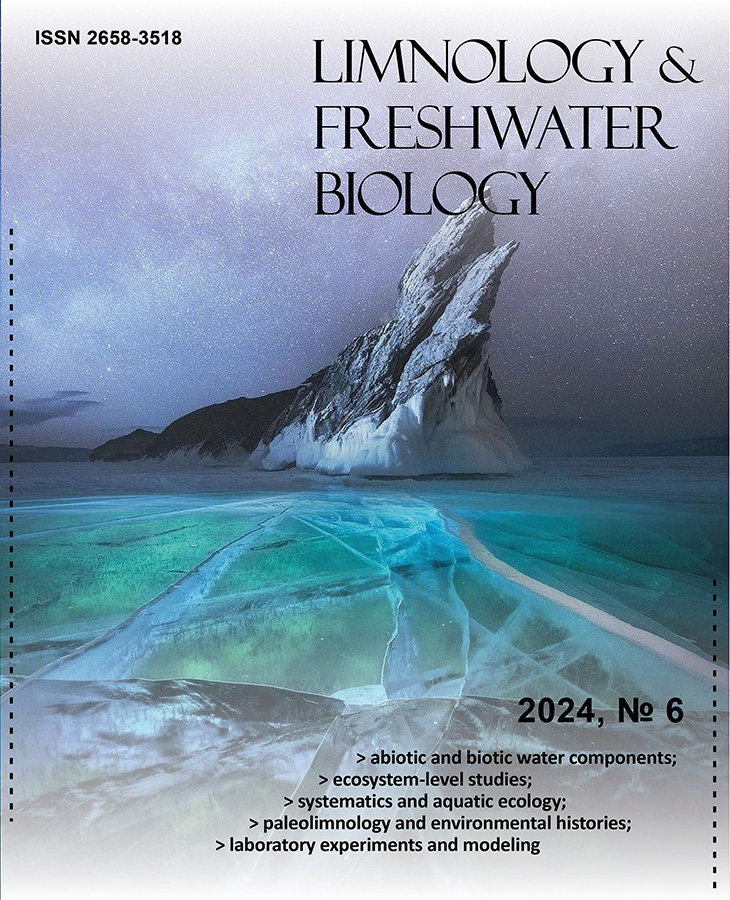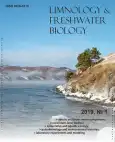No 1 (2019)
Articles
Hidden diversity of micro-eukaryotes in Lake Baikal: a metagenomic approach
Abstract
We have studied the diversity and composition of communities of micro-eukaryotes from two localities: area under anthropogenic impact near the town of Baikalsk and reference area, Irinda Bay, based on high-throughput ITS2 rDNA region sequencing. High taxonomic diversity of micro-eukaryotes has been revealed in both localities studied. However, micro-eukaryotic community from the area under anthropogenic impact is depressed, compared to reference area. Analysis of taxonomic diversity has revealed that community from the area under anthropogenic impact has a trend towards a decrease in diversity. Among the detected taxa, Alveolata, Stramenopiles and Fungi prevailed. Sörensen index of OTUs was 65%, which indicates the similarity of communities studied by taxonomic composition. The spectrum of Alveolata and Stramenopiles taxa identified in the area under the anthropogenic impact and the reference area was similar. The main differences were revealed in spectrum of Fungi taxa.
 150-154
150-154


Metagenomic analysis of viral communities in diseased Baikal sponge Lubomirskia baikalensis
Abstract
Sponges are an ecologically important component of marine and freshwater bodies. Sponge community includes a variety of microorganisms: fungi, algae, archaea, bacteria and viruses. Despite active research in the field of aquatic virology, biodiversity and the role of viruses in sponges are poorly studied. The relevance of research in this area is also related to the worldwide problem of sponge diseases. The aim of this study was to elucidate the genetic diversity of viruses in the associated community of diseased endemic Baikal sponge Lubomirskia baikalensis using metagenomic analysis. As a result, we have shown for the first time a high genetic and taxonomic diversity of DNA viruses in the Baikal sponge community. Identified sequences belonged to 16 viral families that infect a wide range of organisms. Moreover, our analysis indicated the differences in viral communities of visually healthy and diseased branches of the sponge. The approach used in this study is promising for further studies of viral communities in sponges, obtaining more complete information about the taxonomic and functional diversity of viruses in holobionts and entire Lake Baikal, and identifying the role of viruses in sponge diseases.
 155-162
155-162


Morphological and genetic polymorphism of new Diacyclops taxonomic group from Lake Baikal (Copepoda: Cyclopoida)
Abstract
In this study, we have performed morphological and molecular analyses of a phylogenetic group (VIG2) in the complex of Baikal cyclopoids that are morphologically similar to Diacyclops versutus, D. improcerus and D. galbinus. The first internal transcribed spacer (ITS1) and the mitochondrial cytochrome c oxidase subunit I (COI) were chosen as molecular markers. We have measured 27 morphological features and obtained values of 18 morphometric characteristics. We present an illustrated description of the females VIG2. We show that representatives of VIG2 belong to the new taxonomic group Diacyclops in Lake Baikal. Genetic and morphometric differences in the representatives of VIG2 from four locations are comparable to the intraspecific level of differences.
 163-171
163-171


Sponges Lubomirskiidae as bioindicators of the state of Lake Baikal
Abstract
Sponges are ideal bioindicators of the environmental state due to their simple body structure, filter-feeding lifestyle and widespread abundance.For marine sponges, stress response studies are conducted in the field of microbial composition, gene expression and transcriptome techniques. For freshwater sponges expression of the stress protein HSP70 was studied. In the Baikal sponges, the content of HSP70 is an indicator of the stress response to temperature increase. Transcriptomic studies of the endemic Baikal sponges are in progress.
 172-176
172-176


Vertical distribution of zooplankton after rapid change in temperature and chlorophyll concentration
Abstract
In October 2018, after the change in the temperature profile and chlorophyll concentration, we recorded the changes in the distribution parameters of mesozooplankton in the surface 100 m layer at the station located in the pelagic zone of Lake Baikal. The study was carried out on horizons of 0-50 and 50-100 m. Measurements were performed using an AAQ-Rinko water quality probe (JFE, Japan), a SBE-25 CTD probe (SeaBirdElectronics, USA) and a Furuno FCV-1100 sonar (Furuno, Japan). We found a deepening of zooplankton after the immersion of the chlorophyll and temperature maximum.
 177-180
177-180


Validation of 123 names of new diatom taxa from Lake Baikal
Abstract
The monograph “Benthic diatom algae of the family Naviculaceae of Lake Baikal: Atlas and Key” by Pomazkina et al., published in 2018, in Russian, included 123 diatom taxa new to science along with well-known species. The new names were lacking descriptions in English or Latin and thus not in line with ICN. Herein English descriptions for 123 new species and intraspecific taxa are presented to validate new names for baikalian diatom algae.
 181-198
181-198











